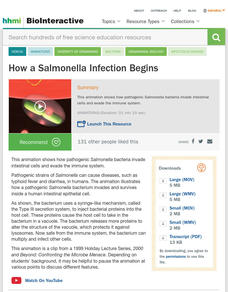Amoeba Sisters
Cell Organelles and Structures Review
Join Pinky and Petunia of the Amoeba Sisters in a review game video! This video provides clues for the viewer to guess the cell organelle or structure before revealing it. As a bonus, towards the end of the video, you'll have the...
Clarendon Learning
Cells for Kids | Learn about cell structure and function in this engaging and fun intro to cells
Cells for kids is an engaging and fun look at the function and structure of cells. In this video we compare the differences between animal and human cells vs plant cells. We first identify the parts of a cell including the Nucleus,...
Curated Video
GCSE Biology - What is Microscopy? #5
In this video, we cover: - The different parts of a microscope - What the terms image, object, magnification and resolution mean Exam board specific info: AQA - Suitable for everyone IGCSE Edexcel - Suitable for everyone Edexcel -...
Mazz Media
Blood Vessels
This live-action video program is about blood vessels. The program is designed to reinforce and support a student's comprehension and retention of the term through use of video footage, photographs, diagrams and colorful, animated...
SciShow
Why Wouldn’t You Put Your Wind Farm In the Windiest Place?
Wind is an ever increasing source of power worldwide, which means wind farms continue to be constructed. And choosing where to place those farms seems straightforward, but it might not actually be best to place the in the windiest places!
Curated Video
Organizing Sample Space Information
In this video, the teacher explains how to organize randomly sampled survey information using tools such as Venn diagrams and tables. They demonstrate how to represent sample spaces, events, and subsets within the data, and provide...
Curated Video
The Anatomy and Function of the Eye
This video is the first of two lecture presentations on the structure and function of the eye. The presenter gives an overview of what the eye is and how it functions as a sensory receptor for detecting changes in light intensity. The...
Curated Video
Sexual Reproduction in Plants | Plants | Biology | FuseSchool
Sexual Reproduction in Plants | Plants | Biology | FuseSchool In this video, we will be looking at sexual reproduction in plants. Did you know that there are an estimated 390,900 plant species known to science? This diversity of plant...
World Science Festival
Nanotechnology’s Promise: A Big Risk in a Small Package?
Microscopic, manmade nanoparticles have found their way into almost every part of our daily lives from clothing, to skin care, our cell phones, and even the soil. But how safe are we from ill effects from extensive exposure? And what...
Professor Dave Explains
Widefield and Confocal Fluorescence Microscopy
We just learned about electron microscopy, so what was the next major innovation in microscopy in the 20th century? That would be fluorescence microscopy, of both the widefield and confocal varieties. How does this work? What is...
Bozeman Science
A Tour of the Cell
Adult humans are made of around 40 trillion cells that can't be seen these without some really powerful microscopes! Learners tour both prokaryotic and eukaryotic cells, learning how their structures are similar and different, and...
Teacher's Pet
Parts of the Eukaryotic Cell
Lipids found in your body include oils, fats, and hormones. The video discusses lipids and their importance to your body, wax, and vitamins. Then, it identifies and explains the job of each part of eukaryotic cells.
Ricochet Science
Prokaryotic Vs. Eukaryotic Cells
Viewers learn about prokaryotic and eukaryotic cells in the third installment of a five-part video series. The video covers the similarities and differences between these two types of cells, including a brief etymological aside on how...
FuseSchool
Intro to Cells: Animal, Plant, Nerve and Red Blood Cells
Throw your dendrites in the air and wave 'em like you just don't care! An excellent video in the Fuse School playlist explains the parts and functions of cells. It describes their structures, functions, and specialties.
Teacher's Pet
Cell History
While Robert Hooke discovered the cell in 1665, the first cell theory didn't come about until the 1830s. The video explains the discovery of the cell and the scientists involved. It continues to the parts of cell theory and the...
Howard Hughes Medical Institute
Intracellular Infection by Salmonella
Bacteria are pesky little organisms that can often easily infect us. But how? Salmonella bacteria literally gets under our skin. Viewers see how the dangerous bacteria protects itself from defense mechanisms inside the cell.
Howard Hughes Medical Institute
The Proteasome
How do cells get rid of worn out proteins? Using a short video clip, viewers learn about the role of ubiquitin in flagging worn-out proteins and see how the proteasome degrades flagged proteins.
Crash Course
Tissues – Types of Connective Tissues (Part 4)
Did you know your blood and bones are examples of connective tissue? This is video number five in a series of 47 and further explores connective tissues. Pupils learn about other types of connective tissues, what these look like, where...
Teacher's Pet
Leaf Structure Lab
Two guard cells protect every stoma on a leaf. The video explains the structures of leaves, including stomatas. It details how to identify the parts under a microscope.
Crash Course
Vision
Your eye cells come in different shapes and serve different functions; rod-shaped cells see shapes and cone-shaped cells see color. Video 18 in the series of 47 teaches all about vision. Scholars see (no pun intended!) how vision works....
Bozeman Science
Bacteria
Is the other side of bacteria called fronteria? Introduce bacteria with a video that covers where it fits on the tree of life, the structure and functions of each part, the shapes and metabolism for various types of bacteria,...
Howard Hughes Medical Institute
Neurons in Parietal Cortex Are Active During Straddling
How do scientists know which parts of the brain various functions use? With the help of an animated cat, viewers observe this process. They listen to the activity of one neuron as the cat steps over an obstacle and hear when the neuron...
American Chemical Society
What's in your Smartphone?
Your cell phone contains many elements you may not have even heard of! Explore the science of the smartphone with a lesson from the Reactions playlist. The instructor explains the location and purpose of the many different elements that...
TED-Ed
The Surprising Reason Our Muscles Get Tired
Does pain really indicate gain when it comes to muscle aches? A short, animated video details the science behind the pain associated with muscle fatigue.

















